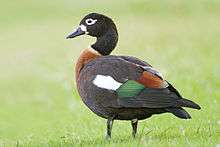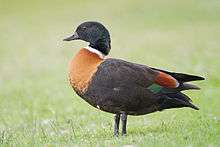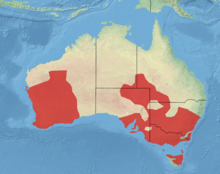Australian shelduck
The Australian shelduck (Tadorna tadornoides), also known as the chestnut-breasted shelduck or mountain duck, is a shelduck part of the bird family Anatidae. The genus name Tadorna comes from Celtic roots and means "pied waterfowl".[2] They are protected under the National Parks and Wildlife Act 1974.
| Australian shelduck | |
|---|---|
 | |
| Female | |
 | |
| Male | |
| Scientific classification | |
| Kingdom: | Animalia |
| Phylum: | Chordata |
| Class: | Aves |
| Order: | Anseriformes |
| Family: | Anatidae |
| Genus: | Tadorna |
| Species: | T. tadornoides |
| Binomial name | |
| Tadorna tadornoides (Jardine & Selby, 1828) | |
 | |
| Distribution | |
Taxonomy and naming
William Jardine and Prideaux John Selby described the Australian shelduck in 1828.
Description
The males are mostly dark, with a chestnut breast. They have white neck collars and dark green heads. The females are similar, but they have white around the eyes and are smaller. Both males and females show a white wing during flight.[3]
Distribution and habitat
The Australian shelduck mainly breeds in southern Australia and Tasmania and is still fairly common.[4] In the winter, many birds move farther north than the breeding range. As with other shelducks, this species has favourite moulting grounds, such as Lake George, New South Wales, where sizeable concentrations occur. The Australian shelduck's primary habitat is lakes in fairly open country. It is extremely wary. It makes its nest in tree holes, holes in banks, or similar locations. Eight to fifteen eggs are laid, and incubated for between thirty and thirty-three days.
References
- BirdLife International (2012). "Tadorna tadornoides". IUCN Red List of Threatened Species. 2012. Retrieved 26 November 2013.CS1 maint: ref=harv (link)
- Kear, Janet (2005). Ducks, Geese, and Swans. Oxford University Press. p. 420. ISBN 0-19-861008-4.
- Kightley, Chris (2010). Wildfowl. A&C Black. p. 165. ISBN 1408138956.
- Ogilvie, Malcolm Alexander; Young, Steve (2002). Wildfowl of the World. New Holland Publishers. p. 60. ISBN 1-84330-328-0.
| Wikispecies has information related to Australian shelduck |
